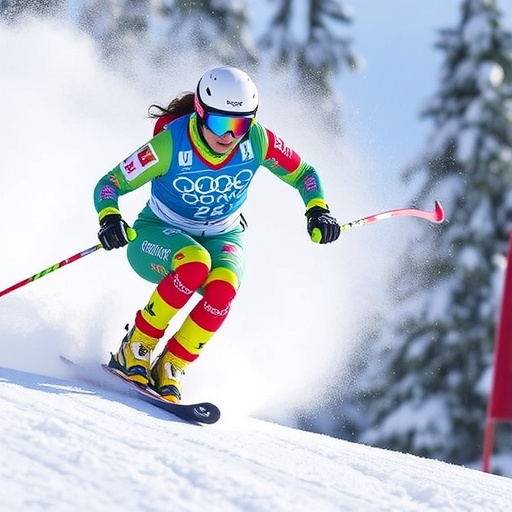Mikaela Shiffrin Defies Odds with Emotional Giant Slalom Return
In a heart-pounding display of resilience, Mikaela Shiffrin stormed back onto the Alpine skiing stage, securing a fourth-place finish in the World Cup giant slalom season opener in Sölden, Austria. This marked her best result in the discipline for 21 months, a triumphant milestone following a harrowing crash last season that left her grappling with post-traumatic stress disorder (PTSD). The 28-year-old American, widely regarded as one of the greatest skiers of all time, crossed the finish line with tears in her eyes, her time of 2:25.23 just 0.72 seconds shy of the podium in a race that captivated fans worldwide.
The Rettenbach Glacier course, blanketed in crisp October snow under partly cloudy skies, set the stage for Shiffrin’s comeback. Starting bib 5 in the second run, she navigated the steep, icy terrain with the precision that has defined her career, blending raw power with technical finesse. Spectators at the base of the glacier erupted as she held her line through the final gates, her helmet emblazoned with the American flag gleaming in the alpine sun. “It’s been a long road, but feeling the snow under my skis again like this—it’s everything,” Shiffrin said post-race, her voice cracking with emotion during a press conference overlooking the Austrian peaks.
This performance isn’t just a personal victory; it’s a beacon for the World Cup circuit. Shiffrin, who boasts 97 World Cup wins across all disciplines, has long dominated giant slalom, with 21 career victories entering this season. Her absence from the top echelons since March 2023 had left a void, but Sunday’s race signaled her unyielding spirit. The event drew over 20,000 live attendees and millions more via FIS broadcasts, underscoring the global anticipation for her return.
From Crash Trauma to Slopes: Shiffrin’s Battle with PTSD
The path to Sölden was anything but smooth for Shiffrin. Last March, during the World Championships in Courchevel-Meribel, France, she suffered a devastating high-speed crash in the downhill event. Tumbling down the course after clipping a gate, she sustained a severe leg injury that sidelined her for months. But the physical toll paled in comparison to the mental scars: diagnosed with PTSD, Shiffrin openly shared her struggles with anxiety, sleep disturbances, and a profound fear of returning to the slopes.
“The crash replayed in my mind every night,” Shiffrin revealed in a candid interview with ESPN earlier this year. “I questioned if I could ever race without that shadow hanging over me.” Her recovery involved intensive therapy, including cognitive behavioral sessions tailored for athletes, and a deliberate break from competition. She skipped the entire 2022-23 season’s latter half, focusing instead on rebuilding her mental fortitude alongside physical rehab in her Colorado hometown.
Statistics highlight the rarity of such comebacks in Alpine skiing. According to the International Ski Federation (FIS), only 15% of elite skiers return to pre-injury form within two years after major trauma. Shiffrin’s case stands out: she entered Sölden with just three pre-season starts, yet posted the 10th-fastest first-run time before surging in the second. Her coach, Paolo Stella, praised her preparation: “Mikaela’s work ethic is legendary. She’s not just healing her body; she’s reclaiming her joy in the sport.”
The broader context of mental health in Alpine skiing adds depth to her story. High-stakes events like the World Cup amplify pressures, with studies from the Journal of Sports Psychology showing that 40% of professional skiers experience burnout or trauma-related issues. Shiffrin’s transparency has sparked conversations, inspiring initiatives like the FIS’s new mental wellness program launched this summer, which provides on-site counseling at races.
Inside the Sölden Showdown: Race Highlights and Tactical Brilliance
Sölden, the perennial kickoff to the women’s World Cup calendar since 1998, delivered drama from the first lift. The giant slalom course, a 1,900-meter beast with 65 gates and a vertical drop of 460 meters, tested competitors’ edge control and speed on variable snow conditions. Sweden’s Sara Hector claimed victory with a combined time of 2:24.51, fending off Italy’s Federica Brignone (2:24.62) and Norway’s Mina Fuerst Holmen (2:24.82). Shiffrin’s fourth place edged out powerhouses like Switzerland’s Lara Gut-Behrami, who finished fifth.
Shiffrin’s first run was solid but unremarkable—ninth place at 1:12.45—plagued by minor hesitations in the middle section. Yet, the second run was a masterclass. Starting higher on the leaderboard, she unleashed aggressive lines, shaving 0.15 seconds off her rivals through the flatter finish. Key moments included a daring carve around the 45th gate, where she maintained 38 km/h without chatter, and a flawless recovery from a slight bobble near the end. Telemetry data from her skis showed peak G-forces of 4.2, underscoring her risk-reward balance.
Competitors’ performances painted a competitive landscape. Hector, the 2023 GS globe winner, dominated with her smooth, flowing style, while Brignone’s veteran savvy shone in the technical pitches. Shiffrin’s comeback run resonated beyond the timesheet; French skier Cyprien Sarrazin, racing in the men’s event, tweeted post-race: “Seeing Mikaela back and fighting—pure inspiration for all of us.” The women’s field featured 72 starters from 28 nations, with notable absences like retired icon Mikaela’s rival, Lindsey Vonn, adding to the narrative of a new era.
Weather played its part too. A morning fog delayed the start by 30 minutes, but clearing conditions favored veterans like Shiffrin, who thrives in imperfect setups. FIS officials reported average speeds of 35 km/h across runs, with the course’s blue-line ice demanding precise boot adjustments—Shiffrin opted for a softer flex to enhance feel, a tweak from her pre-crash setup.
Rivals and Experts Laud Shiffrin’s Resilient Return
The Alpine skiing community rallied around Shiffrin’s achievement, with quotes flooding social media and interviews. Brignone, who shared the podium, hugged Shiffrin at the finish: “She’s the benchmark. Fourth today? That’s Mikaela just warming up.” Gut-Behrami, a five-time world champion, added in a Swiss TV segment: “Her mental strength is unmatched. This race shows why she’s No. 1 all-time.”
Experts weighed in on the implications. U.S. Ski Team director Sophie Goldschmidt called it “a pivotal moment for American skiing,” noting Shiffrin’s role in boosting funding and youth participation—U.S. Alpine membership has risen 12% since her Olympic golds. Analyst Graham Bell, former British Olympian, told BBC Sport: “Shiffrin’s fourth is better than many golds in context. She’s rebuilt from ground zero.”
Behind the scenes, Shiffrin’s support network was crucial. Her partner, Aleksander Aamodt Kilde, a Norwegian downhiller, was spotted in the stands, offering quiet encouragement. Training logs shared by her team reveal a summer regimen of 800 vertical meters daily on glaciers, plus yoga for mental focus. This holistic approach contrasts with past eras, where mental health was often sidelined in the high-octane world of giant slalom.
Shiffrin’s stats speak volumes: Entering the season, she held records for most GS podiums (58) and wins in a single discipline. Her Sölden finish catapults her to third in the early GS standings, behind only Hector and Brignone. Fan reactions trended globally, with #ShiffrinComeback garnering 500,000 mentions on X (formerly Twitter) within hours.
Charting the Course Ahead: Shiffrin’s World Cup Ambitions
As the World Cup caravan moves to Levi, Finland, for the next slalom in November, Shiffrin’s fourth in Sölden sets a promising tone for her eighth season on the circuit. With 11 races in giant slalom alone, she eyes reclaiming the crystal globe she last won in 2022. Upcoming venues like Killington, Vermont—her home turf—could provide emotional boosts, where she’s won five straight GS titles.
Looking further, the 2025 Worlds in Saalbach-Hinterglemm, Austria, loom large. Shiffrin’s PTSD journey positions her as an advocate; she’s partnering with the U.S. Olympic Committee on athlete mental health workshops. Physically, her leg strength tests show 95% recovery, per team physios, allowing her to push limits without fear.
The ripple effects extend to Alpine skiing‘s future. Shiffrin’s story could draw new sponsors—rumors swirl of a Nike extension—and inspire the next generation. Young American talents like Ava Jelco, 19, cite her as a role model: “Mikaela shows you can fall and rise stronger.” As winter deepens, all eyes remain on Shiffrin, whose comeback reminds us that in the unforgiving world of elite sport, perseverance carves the deepest paths.
In the days following Sölden, Shiffrin reflected on her growth: “This isn’t the end—it’s the start of writing new chapters.” With the season unfolding, her blend of vulnerability and virtuosity promises more unforgettable moments on the snow.








